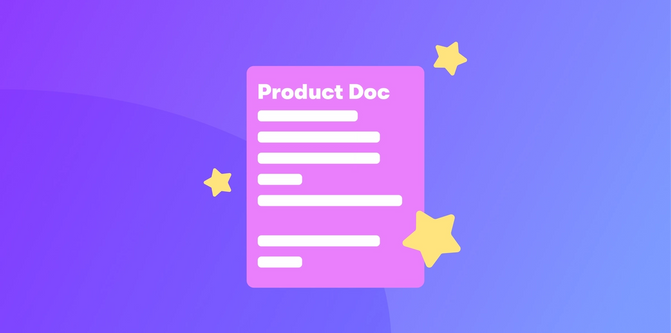Best Practices for Product Documentation

Good product management comes from good product documentation.
Clear documentation is the backbone of product management. There are a lot of considerations here, from considering your audience to AI automation. Let’s take a look.
Decoding the Essentials: What Are Product Documents?
What exactly are product documents, and why do they matter? At their core, product documents encompass a diverse range of materials designed to assist the understanding, implementation, and troubleshooting of a product. From user manuals and installation guides to API documentation and release notes, these documents serve as the bridge between a product's complexity and the end user's ease of use.
Product documents in product management serve a multifaceted role, extending beyond user-centric materials. While user documentation remains a critical component, product managers also generate internal documentation for the benefit of the development team, quality assurance, marketing, and other stakeholders involved in the product lifecycle.
Internal documentation may include technical specifications, project plans, API documentation, and other resources aimed at facilitating seamless collaboration and understanding within the product team. Thus, product documents play a dual role, catering to both external users and internal teams, contributing to the overall efficiency and success of the product development process.
Who Writes Product Documents?
But who shoulders the responsibility of crafting these documents? The task often falls into the hands of technical writers, subject matter experts, and product managers who possess an intimate understanding of the product's intricacies. PMs often take the lead, shaping the overall narrative and ensuring alignment with product vision and goals. They gather information from various stakeholders and translate it into user-friendly language.
Remember: collaboration is key. In larger organizations, the process might involve contributions from various teams, including marketing, customer support, and legal departments. Each brings their unique perspective to ensure comprehensiveness and user-friendliness.
Product Documentation for Product Managers
“Time for the documentation phase!” is one of the daunting phrases for a lot of PMs. Documentation can take various forms such as technical, user, API, software, Project, user stories, design, etc., Effective documentation is essential as it assists in clarity, understanding, and consistency among stakeholders. It helps users and stakeholders to navigate complex systems, troubleshoot issues, and ensure that processes are followed correctly.
Benefits of product documentation include providing a centralized source for all team members to access necessary information promptly. It serves as a form of knowledge management, enabling the sharing and utilization of insights for decision-making processes, design, and guiding further product evolution. Additionally, documentation facilitates communication among teams working on the product and acts as a guide to identify gaps between specifications and planning, ensuring quality for end users.
However, challenges in product management arise due to multiple modifications throughout various stages, making it difficult to track updates in associated documents. Ensuring adherence to templates, naming standards, and terminology poses an additional challenge, especially in larger groups, and can be easily overlooked. Maintaining uniform documentation across numerous stakeholders requires diligence, and the manual process of writing, updating, and maintaining multiple documents in a product delivery demands a rigorous approach.
AI and Product Documentation
The integration of AI into documentation processes has transformative effects on creation, management, and accessibility. This advancement enhances efficiency, accuracy, and user-friendliness across diverse domains and industries. Notably, the speed and efficiency of document creation are significantly increased with AI. Documents can be seamlessly translated into multiple languages, addressing diverse linguistic needs. AI incorporates built-in spelling and grammar checks, reducing the likelihood of human errors. The impact of voice and speech recognition is particularly pronounced during activities such as brainstorming, client feedback, and the product requirements phase. Moreover, since AI is responsible for generating all documents, a consistent language is maintained, offering a standardized format compared to documents created by multiple individuals.
Collato for Product Documentation
Collato is a product manager’s best friend. We’ve made writing, maintaining, and sharing documentation easier than ever. How?
- Generate drafts: Use Collato to quickly draft documents like product requirements documents (PRDs), release notes, user guides, and FAQs. Feed it existing information like meeting notes, user research, and competitor analysis to create a starting point.
- Summarize key information: Get succinct summaries of lengthy documents like customer feedback reports or competitor analysis, helping you efficiently extract key points for documentation.
- Answer product-specific questions: Instead of searching through scattered documents, ask Collato questions directly about your product features, roadmap, or competitor landscape.
- Centralized knowledge base: Create a single source of truth for all your product knowledge, including features, roadmaps, and competitor data. Collato can integrate with different tools and platforms to gather information from various sources.
- Easy search and retrieval: Quickly find specific information within your product documentation thanks to Collato's powerful search capabilities. It can understand synonyms and intent, making it easier to locate relevant details.
- Collaboration and feedback: Share drafts and collaborate with team members within Collato's interface. Gather feedback on documentation easily and track its implementation.
12 Product Documentation Best Practices
- Templates for Repetitive Documents: Streamlining document creation is foundational. Utilizing templates for various document types not only enhances information visibility but also instills a sense of organization. Uniform document naming conventions further contribute to a seamless user experience.
- Standardize the What and Who: Establishing a standardized protocol for updates across the expanse of documentation is not merely a procedural formality but an intricate dance of coordination. A meticulous understanding of who is responsible for what ensures a harmonious workflow, minimizing redundancy and obviating confusion in the aftermath of revisions. Effective communication post-update becomes the linchpin in maintaining a cohesive narrative within the documentation framework.
- Clarity about Audience: In the intricate tapestry of product management, recognizing the diverse perspectives of different teams is not just a nicety but a strategic necessity. Crafting documentation with a keen awareness of the intended audience ensures that each document delivers pertinent information without inundating the reader with unnecessary details. For instance, astute product managers refrain from overwhelming a usability test case with technical intricacies, aligning the depth of information with the specific needs of the audience.
- Protect Intellectual Property & Export Control: Safeguarding the sanctity of intellectual property within product documentation requires a nuanced understanding of what to reveal and what to withhold. The art lies in striking a delicate balance between transparency and discretion, ensuring that the documentation remains a robust tool for communication while steering clear of divulging sensitive details. Simultaneously, adherence to export control guidelines is imperative, creating an environment that facilitates seamless product deliveries without compromising proprietary information.
- Use Clear, Understandable Language: The clarity and precision of language within product documentation can either fortify or erode the foundation of effective communication. In the realm of consumer-centric documents, the judicious avoidance of jargon becomes paramount, ensuring that users comprehend the information effortlessly. Conversely, within technical documents, a delicate dance unfolds, where clarity and specificity reign supreme to foster effective communication within the intricate landscape of the product team.
- Version Control: Navigating the labyrinth of updates demands a sophisticated version control system that transcends the mere chronological tracking of modifications. Each iteration of technical specifications and test cases should be meticulously cataloged, not merely as a historical record but as a strategic resource. This cataloging ensures not only traceability but also facilitates a nuanced root cause analysis when exigencies demand a retrospective examination of the product's evolution.
- Accessibility of Documents: The concept of accessibility within the realm of product documentation extends beyond mere availability; it encapsulates a collaborative ethos that permeates the product team. Ensuring that documents are readily accessible to all team members, irrespective of their roles, fosters a culture of collaboration. This not only promotes cross-functional understanding but also positions documentation as a dynamic and collective resource in the iterative journey of product development.
- Editing Control: Sharing documents is an elementary step, yet managing them with precision demands a level of sophistication that transcends basic permissions. The granular assignment of editing rights, the judicious restriction of changes to file locations, and the deliberate limitation of individuals with editing privileges collectively contribute to preserving the integrity of the documentation. This nuanced approach ensures that collaborative efforts are cohesive and that the documentation remains a pristine reflection of the collective wisdom within the product team.
- Linking of Documents: The interconnected nature of information within the product documentation ecosystem demands more than mere cross-referencing; it necessitates the strategic incorporation of hyperlinks. Instead of relegating reference documents to mere citations, embedding hyperlinks fosters a seamless and efficient flow of information. This not only enhances accessibility but also transforms documentation into a dynamic and interconnected web of knowledge.
- Use of Visual Aids: Elevating comprehension and engagement within the intricate landscape of product documentation involves a strategic integration of visual elements. Incorporating diagrams, user designs, flowcharts, tables, and snapshots wherever contextually appropriate transcends aesthetics. Each visual aid becomes a strategic asset, enhancing the effectiveness of the documentation by providing clarity, context, and a nuanced visual narrative.
- AI-Powered Enhancement: Embracing the capabilities of AI in content creation and enhancement is a forward-looking practice. AI tools can assist in automating repetitive tasks, suggesting language improvements, and even analyzing user interactions to optimize content. Integrating AI into the documentation process ensures a level of efficiency and precision that complements human expertise, allowing product managers to focus on strategic aspects while AI handles routine tasks. This symbiotic relationship between human intuition and AI capabilities propels documentation into a new era of effectiveness and innovation.
- Section on Troubleshooting and FAQs: Anticipating and preempting user queries and challenges is a hallmark of advanced documentation practices. Inclusion of dedicated sections for troubleshooting and frequently asked questions not only demonstrates proactive engagement but also positions the documentation as a dynamic tool for user empowerment. This foresight not only prepares users for potential hurdles but significantly reduces the burden on support channels, optimizing both time and resources.
Documentation may not be an exciting process like a design or a product launch but it is an asset worth investing in!




